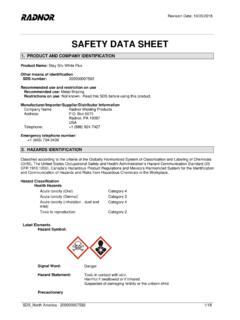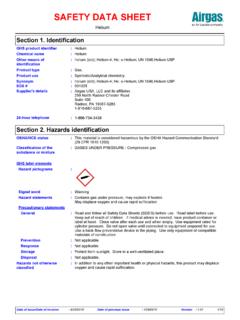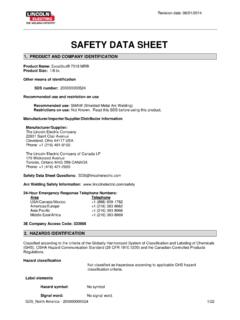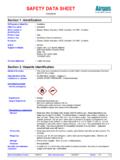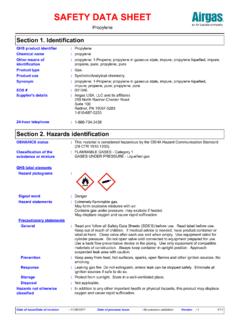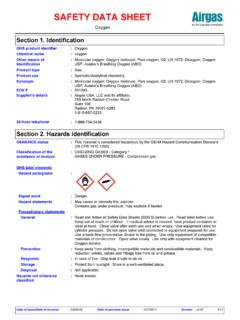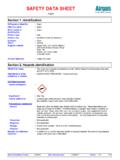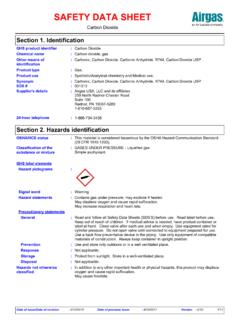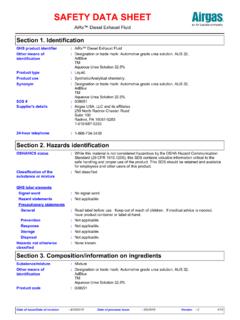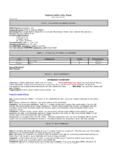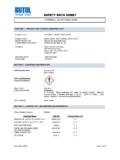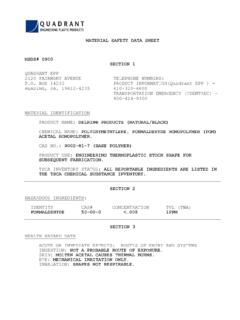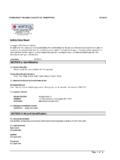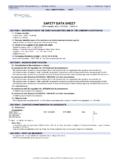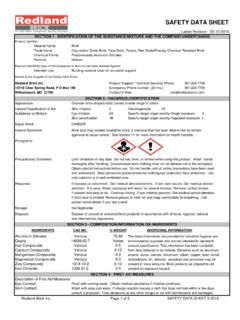Transcription of SAFETY DATA SHEET - Airgas
1 Nitrogennitrogen (dot); nitrogen gas; Nitrogen NF, Nitrogen FGSAFETY data SHEETGHS product identifierOther means of identification24-hour telephoneSection 1. Identification:::Chemical name:nitrogenSupplier's details:NitrogenProduct use:Synthetic/Analytical USA, LLC and its affiliates259 North Radnor-Chester RoadSuite 100 Radnor, PA 19087-52831-610-687-52531-866-734-3438 SDS #:001040 Synonym:nitrogen (dot); nitrogen gas; Nitrogen NF, Nitrogen FGSection 2. Hazards identificationGASES UNDER PRESSURE - Compressed gasClassification of the substance or mixture:Signal word:WarningHazard statements:Contains gas under pressure; may explode if displace oxygen and cause rapid pictograms:Precautionary statementsPrevention:Not :Not :Protect from sunlight when ambient temperature exceeds 52 C/125 F. Store in a well-ventilated :Not label elementsGeneral:Read and follow all SAFETY data Sheets (SDS S) before use. Read label before out of reach of children.
2 If medical advice is needed, have product container or label at hand. Close valve after each use and when empty. Use equipment rated for cylinder pressure. Do not open valve until connected to equipment prepared for a back flow preventative device in the piping. Use only equipment of compatible materials of status:This material is considered hazardous by the OSHA Hazard Communication Standard (29 CFR ).Hazards not otherwise classified:In addition to any other important health or physical hazards, this product may displace oxygen and cause rapid of issue/Date of revision:5/26/2016 Date of previous issue:8/7/2015 3. Composition/information on ingredientsNitrogen1007727-37-9 Ingredient nameCAS number%There are no additional ingredients present which, within the current knowledge of the supplier and in the concentrations applicable, are classified as hazardous to health or the environment and hence require reporting in this name:nitrogenOther means of identification:nitrogen (dot); nitrogen gas; Nitrogen NF, Nitrogen FGCAS number:7727-37-9 Substance/mixtureProduct code:001040 CAS number/other identifiers:Occupational exposure limits, if available, are listed in section concentration shown as a range is to protect confidentiality or is due to batch this product is a gas, refer to the inhalation flush eyes with plenty of water, occasionally lifting the upper and lower eyelids.
3 Check for and remove any contact lenses. Continue to rinse for at least 10 minutes. Get medical attention if irritation contaminated skin with plenty of water. Remove contaminated clothing and shoes. Get medical attention if symptoms occur. Wash clothing before reuse. Clean shoes thoroughly before victim to fresh air and keep at rest in a position comfortable for breathing. If not breathing, if breathing is irregular or if respiratory arrest occurs, provide artificial respiration or oxygen by trained personnel. It may be dangerous to the person providing aid to give mouth-to-mouth resuscitation. Get medical attention if adverse health effects persist or are severe. If unconscious, place in recovery position and get medical attention immediately. Maintain an open airway. Loosen tight clothing such as a collar,tie, belt or waistband. In case of inhalation of decomposition products in a fire,symptoms may be delayed. The exposed person may need to be kept under medical surveillance for 48 4.
4 First aid measuresEye contactSkin contactInhalationIngestion::::Notes to physician:In case of inhalation of decomposition products in a fire, symptoms may be exposed person may need to be kept under medical surveillance for 48 of necessary first aid measuresMost important symptoms/effects, acute and delayedInhalation:No known significant effects or critical this product is a gas, refer to the inhalation section .:IngestionSkin contact:Contact with rapidly expanding gas may cause burns or with rapidly expanding gas may cause burns or frostbite.:Eye contactOver-exposure signs/symptomsSkin contactIngestionInhalationNo specific specific specific data .:::Eye contact:No specific acute health effectsIndication of immediate medical attention and special treatment needed, if necessaryFrostbite:Try to warm up the frozen tissues and seek medical of issue/Date of revision:5/26/2016 Date of previous issue:8/7/2015 4. First aid measuresProtection of first-aiders:No action shall be taken involving any personal risk or without suitable training.
5 It may be dangerous to the person providing aid to give mouth-to-mouth treatments:No specific toxicological information ( section 11) section 5. Fire-fighting measuresPromptly isolate the scene by removing all persons from the vicinity of the incident if there is a fire. No action shall be taken involving any personal risk or without suitable training. Contact supplier immediately for specialist advice. Move containers from fire area if this can be done without risk. Use water spray to keep fire-exposed containers thermal decomposition productsSpecific hazards arising from the chemicalDecomposition products may include the following materials:nitrogen oxidesContains gas under pressure. In a fire or if heated, a pressure increase will occur and the container may burst or should wear appropriate protective equipment and self-contained breathing apparatus (SCBA) with a full face-piece operated in positive pressure protective equipment for fire-fightersUse an extinguishing agent suitable for the surrounding media:::None extinguishing media:Unsuitable extinguishing media:Special protective actions for fire-fighters: section 6.
6 Accidental release measuresEnvironmental precautionsPersonal precautions, protective equipment and emergency proceduresImmediately contact emergency personnel. Stop leak if without risk. Note: see section 1 for emergency contact information and section 13 for waste disposal.::No action shall be taken involving any personal risk or without suitable surrounding areas. Keep unnecessary and unprotected personnel from entering. Avoid breathing gas. Provide adequate ventilation. Wear appropriate respirator when ventilation is inadequate. Put on appropriate personal protective emergency procedures to deal with accidental gas releases are in place to avoid contamination of the environment. Inform the relevant authorities if the product has caused environmental pollution (sewers, waterways, soil or air).Large spill:Immediately contact emergency personnel. Stop leak if without spill:Methods and materials for containment and cleaning upFor non-emergency personnelFor emergency responders:If specialised clothing is required to deal with the spillage, take note of any information in section 8 on suitable and unsuitable materials.
7 See also the information in "For non-emergency personnel". section 7. Handling and storageProtective measuresPut on appropriate personal protective equipment (see section 8). Contains gas under pressure. Avoid contact with eyes, skin and clothing. Avoid breathing gas. Empty containers retain product residue and can be hazardous. Do not puncture or incinerate container. Use equipment rated for cylinder pressure. Close valve after each use and when empty. Protect cylinders from physical damage; do not drag, roll, slide, or a suitable hand truck for cylinder movement.:Precautions for safe handlingDate of issue/Date of revision:5/26/2016 Date of previous issue:8/7/2015 7. Handling and storageAdvice on general occupational hygieneConditions for safe storage,including any incompatibilitiesEating, drinking and smoking should be prohibited in areas where this material is handled, stored and processed. Workers should wash hands and face before eating,drinking and smoking.
8 Remove contaminated clothing and protective equipment before entering eating areas. See also section 8 for additional information on hygiene in accordance with local regulations. Store in a segregated and approved away from direct sunlight in a dry, cool and well-ventilated area, away from incompatible materials (see section 10). Keep container tightly closed and sealed until ready for use. Cylinders should be stored upright, with valve protection cap in place,and firmly secured to prevent falling or being knocked over. Cylinder temperatures should not exceed 52 C (125 F).::NitrogenOxygen Depletion [Asphyxiant] section 8. Exposure controls/personal protectionIngredient nameExposure limitsHand protectionUse a properly fitted, air-purifying or air-fed respirator complying with an approved standard if a risk assessment indicates this is necessary. Respirator selection must be based on known or anticipated exposure levels, the hazards of the product and the safe working limits of the selected , impervious gloves complying with an approved standard should be worn at all times when handling chemical products if a risk assessment indicates this is necessary.
9 Considering the parameters specified by the glove manufacturer, check during use that the gloves are still retaining their protective properties. It should be noted that the time to breakthrough for any glove material may be different for different glove manufacturers. In the case of mixtures, consisting of several substances, the protection time of the gloves cannot be accurately eyewear complying with an approved standard should be used when a risk assessment indicates this is necessary to avoid exposure to liquid splashes, mists,gases or dusts. If contact is possible, the following protection should be worn, unless the assessment indicates a higher degree of protection: SAFETY glasses with protectionRespiratory protection:::Body protectionPersonal protective equipment for the body should be selected based on the task being performed and the risks involved and should be approved by a specialist before handling this product.
10 :Environmental exposure controls:Emissions from ventilation or work process equipment should be checked to ensure they comply with the requirements of environmental protection legislation. In some cases, fume scrubbers, filters or engineering modifications to the process equipment will be necessary to reduce emissions to acceptable engineering controls:Good general ventilation should be sufficient to control worker exposure to airborne hands, forearms and face thoroughly after handling chemical products, before eating, smoking and using the lavatory and at the end of the working techniques should be used to remove potentially contaminated contaminated clothing before reusing. Ensure that eyewash stations and SAFETY showers are close to the workstation measures:Control parametersIndividual protection measuresOccupational exposure limitsSkin protectionOther skin protection:Appropriate footwear and any additional skin protection measures should be selected based on the task being performed and the risks involved and should be approved by a specialist before handling this of issue/Date of revision:5/26/2016 Date of previous issue:8/7/2015 9.

